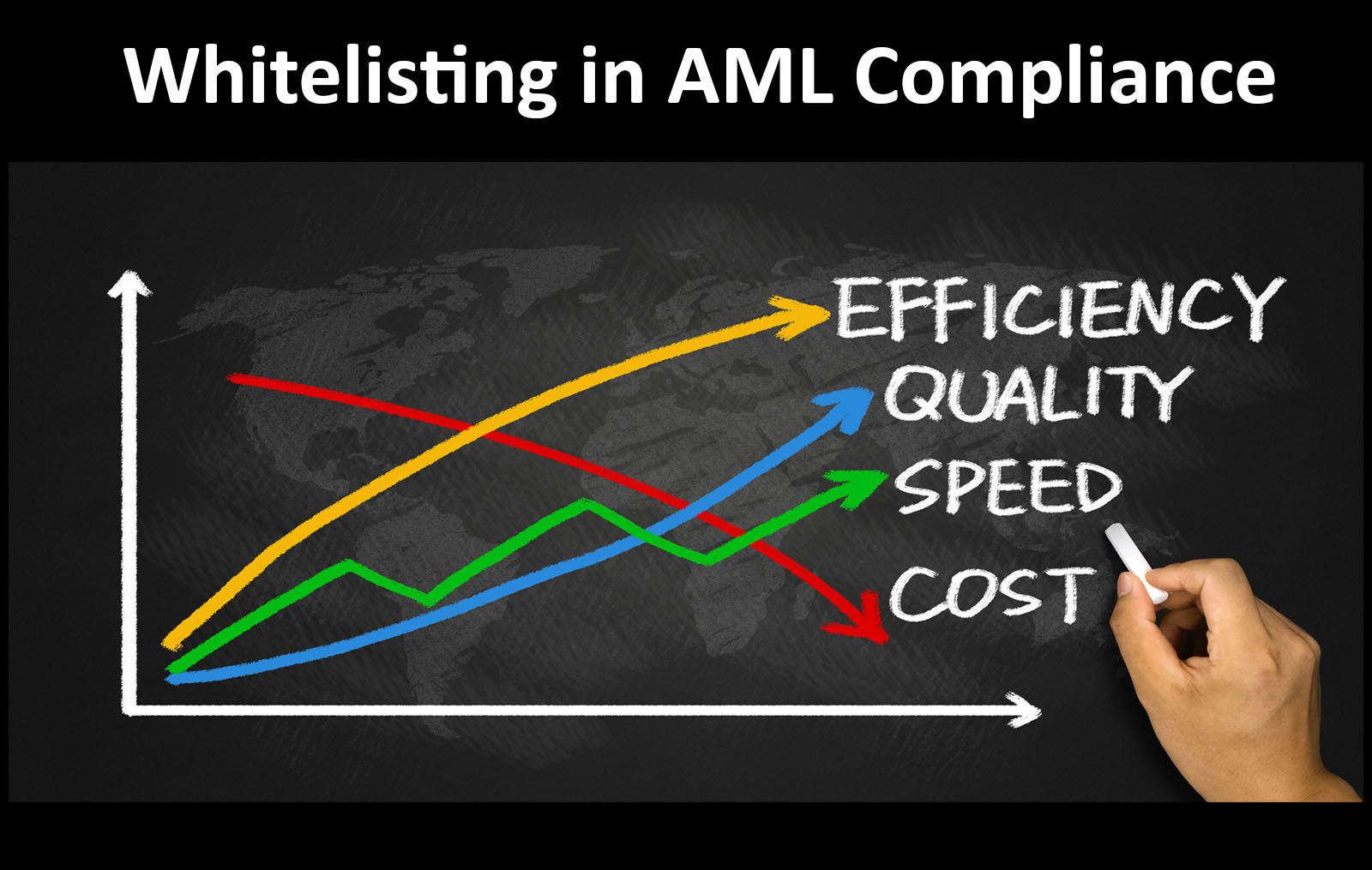
Use whitelisting, deduplication, and secondary evaluation for efficient, accurate AML sanctions screening and transaction monitoring
By Frank Cummings, CEO
What is whitelisting in AML Compliance?
Whitelisting in AML Compliance refers to the process of a financial institution marking screening and monitoring hits as false positives when they are known to be so. Entities and individuals who are well known and trusted by institutions often warrant whitelisting in order to remediate false-positive hits. This allows companies to focus time and resources on actual risk, which greatly streamlines their OFAC compliance (Office of Foreign Asset Control) and related AML efforts.
With AML software, false positives during transaction monitoring and sanctions screening often create regular avalanches of work for analysts. False positives are screening and monitoring ‘hits’ known by the financial institution to be inaccurate. Dealing with hundreds or thousands of false positives drains institutions of time and money. Effective whitelisting, therefore, can be a game-changer in remediating false positives in AML Compliance.
When is whitelisting in AML appropriate?
Whitelisting is appropriate when Compliance professionals can systematically identify trusted entities or individuals eligible for whitelisting. Whitelisting means that authorized Compliance professionals have identified and pre-approved trusted parties. Trusted parties will already have completed comprehensive due diligence. And trusted parties will pose a low risk of involvement in illicit activities. By whitelisting these trusted entities, the institution can justifiably lessen the level of scrutiny and enhanced compliance requirements. This is in contrast to the scrutiny and AML requirements for customers identified as posing higher risks.
Whitelisted entities might include government agencies, reputable corporations, or individuals or entities with a long-established relationship and a history of compliance with the financial institution. These trusted entities may be subject to simplified or expedited due diligence processes and may have lower transaction monitoring thresholds compared to non-whitelisted parties.
Imagine, for example, a ‘single originator to multiple beneficiaries’ situation. This is sometimes referred to as the terrorism rule. This describes one person or entity sending money from a bank account to multiple people or entities. This is a transaction behavior common among financers of terror. But it’s also common legitimate behavior for some corporate accounts. Without whitelisting, AML software might flag a longstanding and trusted corporate account for the ‘terrorism rule’—creating a false positive.
Whitelisting allows an institution to whitelist a trusted corporate account whose expected (i.e. normal) transaction behavior is to send out multiple payments to its vendors. With automated whitelisting, an AML software solution can be configured to automatically waive the false positives. Prior to automated whitelisting, an actual human analyst would have had to manually waive that case every month.
The process of whitelisting—especially when implemented on leading AML software platforms—can improve exponentially the effectiveness and efficiency of working through false positives from screening and transaction monitoring.
Effective AML whitelisting requires strong controls
Overcoming the critical problem of false positives requires high quality AML software solutions. Modern AML software should allow users to list trusted individuals or entities that should be exempted from selected rules run by the AML software.
To be clear, your AML software should still create cases for false positives. Also, these cases should be available for audit if needed. Even though cases are still created, robust whitelisting greatly impacts efficiency by preemptively waiving a case known to be a false positive.
Specific criteria and processes for whitelisting will vary depending on each institution’s own policies and the jurisdictions in which they do business. Financial institutions should establish robust and fully documented processes for maintaining their whitelist and for configuring their AML software solutions.
Institutions should also adhere to requirements for periodic reviews. And they should adhere to procedures that ensure that trusted entities continue to meet compliance requirements.
Use whitelisting—and also deduplication and secondary evaluation–in AML Compliance
In addition whitelisting, AML software solutions should feature deduplication and secondary evaluation. Used together, whitelisting, deduplication, and secondary evaluation greatly improve remediation of false positives.
Automated deduplication
Along with whitelisting, automated deduplication is another key tool in dealing with false positives. The deduplication process in AML software refers to identifying and removing duplicate records from a dataset.
Deduplication helps eliminate duplicate entries so that each entity or individual appears only once. This greatly improves efficiency because accurate analysis can occur a single time—rather than many times for duplicate entries.
Deduplication—or ‘deduping’–is generally used with customer or entity data. This often includes data like names, addresses, ID numbers, etc. Effective deduping software will use various algorithms to automatically identify and waive duplicate records. This provides for the financial institution a single accurate look at each customer or entity within the system.
Automated secondary evaluation
Another key tool to improve the efficiency and effectiveness of screening in AML Compliance is secondary evaluation. When automated whitelisting, deduplication, and secondary evaluation are used together, institutions maximize accuracy and save money.
The key to secondary evaluation by an AML software solution is to identify true hits by matching the name or entity to other key details. This occurs during automated secondary evaluation. For example, a screening run might return hundreds or thousands of hits on a name. Secondary evaluation for details like matching phone numbers, addresses, and company affiliations can pick out the needle in the haystack of false positives. And a good software solution can do that automatically.
Save time and money with whitelisting, deduplication, & secondary evaluation
In summary, effective and systematic whitelisting provides a powerful tool to deal with the avalanche of false positives that AML software can generate. And combining automated whitelisting with automated deduplication and secondary-evaluation tools takes effectiveness and efficiency to the highest levels.
To learn more about the causes of false positives, check out this article. To learn more about whitelisting, deduplication, and secondary evaluation, contact us today. Or check out our AML solutions for screening and transaction monitoring on the RegTechONE platform.

